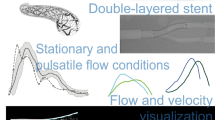Abstract
Purpose
To study the influence of a newly developed membrane stent design on flow patterns in a physiologic carotid artery model.
Methods
Three different stents were positioned in silicone models of the carotid artery: a stainless steel stent (Wall-stent), a nitinol stent (SelfX), and a nitinol stent with a semipermeable membrane (MembraX). To increase the contact area of the membrane with the vessel wall, another MembranX model was modified at the outflow tract. The membrane consists of a biocompatible silicone-polyurethane copolymer (Elast-Eon) with a pore size of 100 μm. All stents were deployed across the bifurcation and the external carotid artery origin. Flow velocity measurements were performed with laser Doppler anemometry (LDA), using pulsatile flow conditions (Re = 220; flow 0.39 l/min; flow rate ratio ICA:ECA = 70:30) in hemodynamically relevant cross-sections. The hemodynamic changes were analyzed by comparing velocity fluctuations of corresponding flow profiles.
Results
The flow rate ratio ICA:ECA shifted significantly from 70/30 to 73.9/26.1 in the MembraX and remained nearly unchanged in the SelfX and Wallstent. There were no changes in the flow patterns at the inflow proximal to the stents. In the stent no relevant changes were found in the SelfX. In the Wallstent the separation zone shifted from the orifice of the ICA to the distal end of the stent. Four millimeters distal to the SelfX and the Wallstent the flow profile returned to normal. In the MembraX an increase in the central slipstreams was found with creation of a flow separation distal to the stent. With a modification of the membrane this flow separation vanished. In the ECA flow disturbances were seen at the inner wall distal to the stent struts in the SelfX and the Wallstent. With the MembraX a calming of flow could be observed in the ECA with a slight loss of flow volume.
Conclusions
Stent placement across the carotid artery bifurcation induces alterations of the physiologic flow behavior. Depending on the stent design the flow alterations are located in different regions. All the stents tested were suitable for the carotid bifurcation. The MembraX prototype has shown promising hemodynamic properties ex vivo.








Similar content being viewed by others
References
JD Barr et al. (2003) ArticleTitleQuality improvement guidelines for the performance of cervical carotid angioplasty and stent placement J Vasc Interv Radiol 14 S321–S335
R Ahmadi A Willfort A Lang et al. (2001) ArticleTitleCarotid artery stenting: Effect of learning curve and intermediate-term morphological outcome J Endovasc Ther 8 539–546
FJ Veith M Amor T Ohki et al. (2001) ArticleTitleCurrent status of carotid bifurcation angioplasty and stenting based on a consensus of opinion leaders J Vasc Surg 33 11–116
MH Wholey M Wholey (2003) ArticleTitleCurrent status in cervical carotid artery stent placement J Cardiovasc Surg 44 331–339
DN Ku DP Giddens (1985) ArticleTitleHemodynamics of the normal human carotid bifurcation: In vitro and in vivo studies Ultrasound Med Biol 11 13–26
CW Kerber D Liepsch (1994) ArticleTitleFlow dynamics for radiologists. I. Basic principles of fluid flow AJNR Am J Neuroradiol 15 1065–1075
CW Kerber D Liepsch (1994) ArticleTitleFlow dynamics for radiologists. II. Practical considerations in the live human AJNR Am J Neuroradiol 15 1076–1086
O Greil G Pflugbeil K Weigand W Weiss D Liepsch PC Maurer H Berger (2003) ArticleTitleChanges of carotid artery flow velocities after stent implantation: A fluid dynamics study with laser-Doppler-anemometry J Endovasc Ther 10 275–284
S Müller-Hülsbeck T Jahnke P Stolzmann F Paulsen R Wenke M Heller (2003) ArticleTitleA new concept for covered stent protected carotid angioplasty: An ex vivo study RoFo Fortschr Geb Rontgenstr Neuen Bildgeb Verfahr 175 1634–1638
D Liepsch St Moravec R Baumgart (1992) ArticleTitleSome flow visualization and laser Doppler-velocity measurements in a true-to-scale elastic model of a human aortic arch. A new model technique Biorheology 29 563–580
T Ohki (2003) ArticleTitleThe dark side of embolic protection devices Endovasc Today 9 54–60
A Kastrup K Gröschel H Krapf BR Brehm J Dichgans JB Schulz (2003) ArticleTitleEarly outcome of carotid angioplasty and stenting with and without cerebral protection devices. A systematic review of the literature Stroke 34 813–819 Occurrence Handle10.1161/01.STR.0000058160.53040.5F Occurrence Handle12624315
S Glagov C Zarins DP Giddens DN Ku (1988) ArticleTitleHemodynamics and atherosclerosis. Insights and perspectives gained from studies of human arteries Arch Pathol Lab Med 112 1018–1031
P Ma X Li DN Ku (1997) ArticleTitleConnective mass transfer at the carotid bifurcation J Biomech 30 565–571
SZ Zhao XY Xu AD Hughes SA Thom AV Stanton B Ariff Q Long (2000) ArticleTitleBlood flow and vessel mechanics in a physiologically realistic model of a human carotid arterial bifurcation J Biomech 33 975–984
PF Davies (1995) ArticleTitleFlow-mediated endothelial mechanotransduction Physiol Rev 75 519–551
PF Davies (1997) ArticleTitleMechanisms involved in endothelial responses to hemodynamic forces Atherosclerosis 131 IssueID(Suppl) 15–17
PF Davies (1997) ArticleTitleOverview: Temporal and spatial relationships in shear stress-mediated endothelial signaling J Vasc Res 34 208–211
KA Barbee PF Davies R Lal (1994) ArticleTitleShear stress-induced reorganisation of the surface topography of living endothelial cells imaged by atomic force microscopy Circ Res 74 163–171
DW Liepsch G Pflugbeil PC Maurer C Weigand (1994) LDA measurements in anatomically distensible carotid artery models under physiological conditions DW Liepsch (Eds) Biofluid mechanics. Proceedings of the 3rd International Symposium 17 VDI Verlag, Reihe Biotechnik 593–602
Acknowledgment
This study was supported in part by the DFG under contract Li 256-49. Abbott Company provided us with the stent designs and application systems.
Author information
Authors and Affiliations
Corresponding author
Rights and permissions
About this article
Cite this article
Greil, O., Kleinschmidt, T., Weiss, W. et al. Flow Velocities After Carotid Artery Stenting: Impact of Stent Design. A Fluid Dynamics Study in a Carotid Artery Model with Laser Doppler Anemometry. Cardiovasc Intervent Radiol 28, 66–76 (2005). https://doi.org/10.1007/s00270-004-0040-6
Published:
Issue Date:
DOI: https://doi.org/10.1007/s00270-004-0040-6




